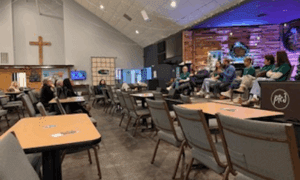t is a disaster that no community wants to see. But it happened last year in Adairsville when an F3 tornado leveled portions of the northwest Georgia city. Former Adairsville City Manager Pat Crook and Bartow County EMA Director Paul Cuprowski presented the circumstances of the tornado’s aftermath at the annual Fayette County Faith-based Disaster Network meeting held Feb. 8 at New Hope Baptist Church. The presentation was a primer on the effective role churches can play in disaster response.
It was in January 2013 that an F3 tornado tore through a portion of Adairsville in Bartow County.
“Most roadways were impassable. People were trapped in their homes and businesses. The tornado changed the culture of the community,” Crook said. “The priority was to establish a control center since power lines were down, gas and water lines were broken and people were wandering around in shock.”
The quarter-mile-wide tornado cut a two-mile swath that went right through the town of less than 5,000 people, Crook said.
“It seemed to come and go in the blink of an eye,” she said. “It was scary quiet afterward. Cars and trucks were on roofs, cell phones and police radios were down. But law enforcement from all over flooded into the area. And search and rescue began immediately.”
Crook said the primary goals in the aftermath of the tornado were to organize response activities. Roads were blocked and checkpoints were set up to let volunteers in. Those volunteers were among the mass of onlookers who also arrived in the town that now resembled a war zone.
Crook and Cuprowski described the rapid-fire efforts to quickly set up the control center, develop a safety plan, assess and respond to emergencies and provide food and shelter to those in need. It was an effort facilitated by local residents and thousands of volunteers who poured into Adairsville over the next few months.
Central to the effort were churches and the members of Team Rubicon, a veterans group, who arrived and helped set up a management structure for the faith-based volunteers whose efforts were so instrumental in response.
“You are leaps and bounds ahead of where we were,” Cuprowski told the Fayette church group. “Don’t ever think what you‘re doing is not important.”
Cuprowski stressed repeatedly that faith-based groups worked with local government, adding that “government understood how powerful the faith-based community is.”
And it was the faith-based community that also took care of people’s spiritual needs as well as their physical needs, Cuprowski emphasized.
The volunteer effort was massive, coming from across Georgia, including the group from Fayette County, from other states such as Missouri and Michigan, area Boy Scout troops and a National Guard unit from Chattanooga. And there were the faith-based groups – Hindus, Jews, Buddhists, Protestants and Catholics. They all worked together, all 20,000 volunteers over a period of eight months, Cuprowski said.
Stressed multiple times by Crook and Cuprowski and though phrased in multiple ways, the idea was clear. In times of crisis, differences make no difference when people are united in a common goal. And in Adairsville, the goal was to restore a community that had been devastated by nature’s wrath. And through it all, the efforts of the faith-based community shone bright.
Fayette County Fire and Emergency Services Division Chief Pete Nelms after the meeting said the conference was well-received, offering thanks to New Hope Baptist and the Ga. Dept. of Public Health for co-sponsoring the conference.
“The conference was excellent. We’re looking forward to expanding it next year,” Nelms said. “I hope to sign up more people for the disaster teams.”
Those wishing to be part of the Faith-based Disaster Network activities within their church or organization or those with additional questions are asked to contact Pete Nelms at [email protected]
Nelms said in 2012 the Fayette County Emergency Management Agency embarked on a new initiative called the Fayette County Faith-based Disaster Network. The purpose of this initiative is to better coordinate the many individual volunteers and faith-based organizations that are willing to assist emergency management agencies and their community during times of disaster. Prior disaster events have convincingly demonstrated that faith-based volunteers are a valuable resource to help the community recover from a disaster incident in a variety of ways, said Nelms.
“The Fayette County Emergency Management Agency conducted a comprehensive study of specific community needs during and after the four presidentially declared disasters that have affected Fayette County over the past 20 years,” Nelms said of the objective associated with the faith-based network. “With input from the faith-based community, it was determined that 10 Volunteer Support Functions (VSF) should be established in order to provide coordination and to create an organizational platform for faith-based volunteers and agencies that are willing to assist during disasters.”
Those functions include volunteer management teams, debris cleanup teams, damage assessment teams, points of dispensing and distribution teams, disaster counseling teams, shelter management teams, communications teams, donated goods management teams, animals in disaster teams and special skill sets teams.
“Throughout history, best practice emergency management activities has proven that it is the faith-based community that is always willing to assist their community recover from a disaster,” said Nelms. “The Fayette County Faith-Based Disaster Network is a program by which first response agencies are partnering with volunteers and various groups prior to a disaster in an effort to better organize and reduce human suffering and speed the recovery process in our community.”












Leave a Comment
You must be logged in to post a comment.